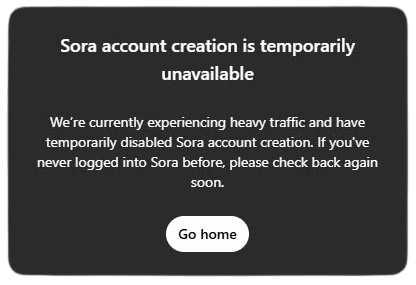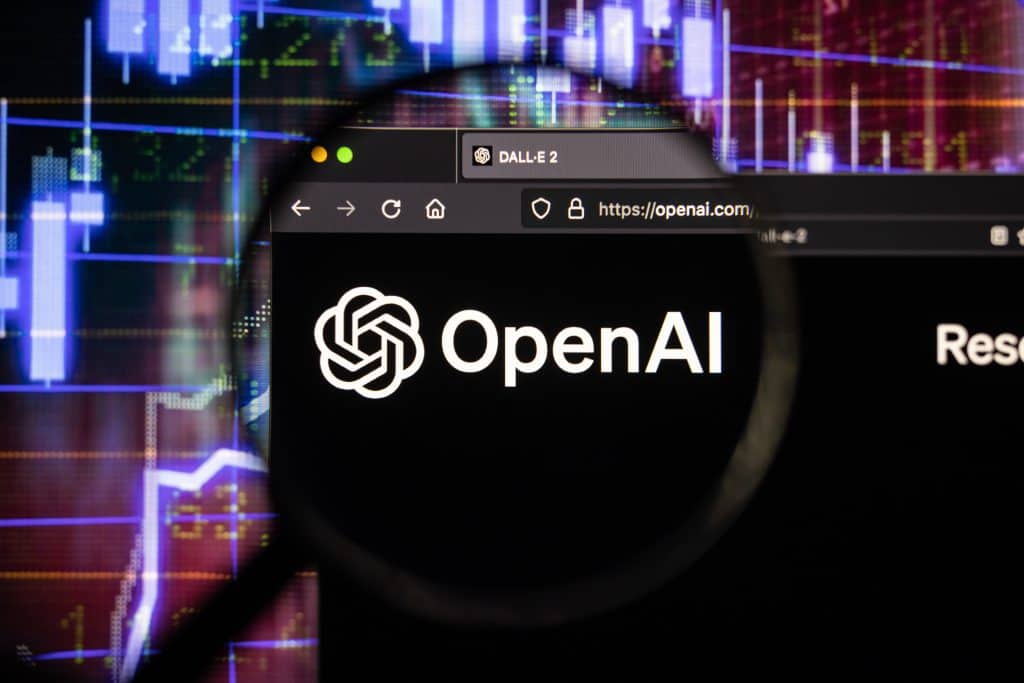Powerful AI Video Creation in 2024! (Almost)
Yes, Powerful AI Video Creation in 2024 has arrived! Or has it?
OpenAI has extended its generative AI offerings with the recent launch of Sora. This text-to-video platform is truly amazing and allows users to create high-fidelity videos by simply inputting text prompts. Released as part of OpenAI’s “12 Days of OpenAI” holiday initiative, Sora is available to ChatGPT Plus and Pro subscribers at no additional cost. “Our holiday gift to you is here: Sora is here,” OpenAI wrote on X, alongside an image of a holiday ornament in front of a tree. “We hope that this early version of Sora will help people explore new forms of creativity.”
This advanced tool builds on OpenAI’s multimodal AI strategy, combining text, images, and now videos to serve creative industries and businesses alike. But there’s a problem. It was released yesterday, Monday, December 9, 2024, and just a few hours later, account creation was temporarily disabled due to high volume. That’s how many people want to try this thing.
I tried to create an account around 8 p.m. ET on the day of its release but was unable to do so. Oh well, we’ll see how long it takes for them to open it back up. I’m chomping at the bit to get my hands on it, but I’ll just have to be patient.

Sora empowers users to generate short videos of up to 20 seconds, with additional features like animating still images, remixing content, and designing complex storyboards. When they first announced it they said the video limit was going to be a full minute, but things changed at release time. While the tool showcases immense creative and professional potential, it has also sparked discussions about ethical practices, fair compensation for artists, and the broader implications of AI-driven video tools.
This article breaks down Sora’s features, capabilities, pricing, industry reception, and market implications, providing small and medium-sized businesses (SMBs), content creators, and brands with a comprehensive look into how they can harness its incredible power responsibly and effectively.
The Vision Behind OpenAI Sora
The release of Sora aligns with OpenAI’s ongoing mission to expand AI capabilities beyond static text and image generation. OpenAI CEO Sam Altman emphasized that this product is intended to help society explore creative frontiers while maintaining an ethical framework as AI-generated video content becomes more prevalent.
By incorporating video into its suite of generative AI tools, OpenAI seeks to bridge the gap between artistic creativity and automation, opening up new possibilities for businesses and creators alike. With text-to-video capabilities, these tools are positioned to streamline workflows across industries such as marketing, filmmaking, social media management, and graphic design.
However, alongside this promise comes a commitment to setting safeguards and norms. Sora is being released incrementally to prioritize responsible use, mitigate potential misuse—such as the creation of misinformation and deepfakes—and engage users in building shared practices around ethical implementation.
I don’t believe you can even generate videos with people in it yet. I think is a good thing.
Key Features and Capabilities

Sora represents an evolution in generative AI, offering a suite of powerful features designed to inspire creativity and efficiency. These features include:
Text-to-Video Generation
Using advanced AI models, Sora transforms written prompts into high-definition, dynamic video clips, producing visuals such as bustling cityscapes, natural landscapes, or imagined fantasy worlds. The generated videos can display multi-character action, intricate camera movements, and creative scene blends.
Photo-to-Video Conversion
Users can input static images and animate them seamlessly with Sora’s photo-to-video functionality. For example, a still image of a serene meadow can be converted into a looped video with swaying grass and fluttering butterflies.
Remix and Scene Blending Tools
Sora enables users to modify AI-generated videos with additional prompts or remix existing content. The “Blend” feature is particularly innovative, allowing video creators to merge two scenes into one coherent, visually striking clip.
Storyboards for Structured Narratives
For marketers and content creators, Sora simplifies complex projects by allowing multiple prompts to be stitched together into storyboard-like sequences, helping visualize product concepts, narratives, or campaign ideas.
High-Resolution Output
Sora Turbo, the enhanced version of the platform, allows users to produce videos at resolutions of up to 1080p, ensuring professional-quality visuals suitable for commercial and creative applications.
Sora Pricing and Accessibility
Sora is free for users who already have an existing ChatGPT Plus or Pro plans, making pricing straightforward for users already familiar with OpenAI’s ecosystem.

ChatGPT Plus ($20/month)
- Generate up to 50 videos per month.
- Videos capped at 720p resolution with a maximum duration of five seconds.
ChatGPT Pro ($200/month)
- Generate up to 500 videos per month, with video durations of up to 20 seconds.
- Videos available in 1080p resolution with no watermarks.
- Ability to produce up to five videos simultaneously.
Tailored subscription models tailored for different industries and use cases are planned for early 2025.
Despite its availability in many regions, Sora is currently inaccessible in the European Economic Area, Switzerland, and the UK due to regulatory challenges and system scaling considerations.
Safety Measures and Ethical Guardrails
As with other generative AI tools, Sora’s potential for abuse—such as creating deepfakes or spreading misinformation—has necessitated stringent safeguards. OpenAI has implemented several security measures to address these concerns:
Watermarks and Metadata
Every Sora-generated video includes visible watermarks and metadata using the Coalition for Content Provenance and Authenticity (C2PA) standard, ensuring transparency in identifying AI-generated content.Content Moderation Policies
Sora operates under conservative guidelines, prohibiting content involving minors, explicit violence, or copyrighted material. Violation of these rules can result in user bans, ensuring compliance and safety.Guardrails for Specific Prompts
OpenAI has blocked or limited prompts that could produce controversial, harmful, or inappropriate outputs, with evolving adjustments based on user feedback.- Collaborations Against Abuse
OpenAI has partnered with organizations like the National Center for Missing & Exploited Children to actively monitor and prevent illegal activities like child exploitation.
Sora Controversy and Artist Backlash
Sora’s public launch follows months of controversy, primarily stemming from OpenAI’s alpha testing phase. Artists granted early access leaked internal information in protest, accusing OpenAI of exploiting their unpaid labor for product refinement and marketing purposes. Their complaints revolved around perceived “art-washing” and lack of meaningful compensation or transparency.
In response, OpenAI emphasized that participation in Sora’s testing was voluntary and offered free access to the platform. The company has also introduced initiatives like artist-in-residence programs and grants to support creative professionals. However, critics argue these measures fall short compared to the revenue-generating potential of tools like Sora.
Reception and Early Feedback
The reception to Sora has been mixed, with technology reviewers, artists, and businesses expressing both excitement and skepticism.
Strengths Highlighted
Industry voices like Wired and MIT Technology Review have praised Sora’s grasp of cinematic grammar and its ability to create visually compelling videos.Challenges Noted
Critics, however, underscore its inability to handle complex scenarios, such as intricate physics or extended narratives. Additionally, early issues with accurately rendering human faces have raised questions about Sora’s current limitations in professional-grade applications.Cultural Concerns
In addition to the industry backlash, professionals in the arts fear Sora could disrupt traditional creative roles, threatening job security for filmmakers, animators, and designers.
Business Implications: Opportunities and Challenges
For SMBs, content creators, and personal brands, Sora brings an innovative, cost-effective way to elevate marketing and creative efforts. By automating video production, businesses can save time and resources while focusing on strategy and storytelling.
Opportunities:
- Enhanced Campaigns: Marketing agencies can use storyboard features, remix tools, and AI-generated stock footage to streamline content creation.
- Social Media Optimization: Sora’s text-to-video functionality allows brands to quickly turn ideas into engaging TikToks, Instagram Reels, or YouTube Shorts.
- Cost Efficiency: Businesses previously constrained by the high costs of video production can use AI tools to scale their content without breaking the budget.
Challenges:
- Ethical Accountability: Brands must use Sora responsibly, avoiding content that could mislead or harm their audiences.
- Quality Limitations: While highly advanced, Sora’s steep learning curve for intricate outputs could require creative professionals to intervene manually.
Broader Implications for Video AI
Sora’s introduction is a milestone in the rapidly expanding generative AI market, which analysts project will reach $1 trillion in revenue over the next decade. As video overtakes text and images as the dominant medium for communication, tools like Sora are set to redefine how businesses and individuals approach content production.
Still, the industry faces mounting concerns about the societal impacts of AI tools, including the proliferation of misinformation and erosion of creative authenticity. OpenAI’s deliberate rollout demonstrates an awareness of these challenges, but regulation and societal norms will need to evolve in tandem to fully address them.
Sora represents a leap forward in generative AI video tools, combining advanced capabilities with safeguards for ethical and responsible usage. While it has sparked debate over its limitations and development practices, the platform opens exciting possibilities for streamlining creative processes across industries.
For businesses ready to adapt AI technologies into their workflows, Sora offers a glimpse into the future of content production, marked by automation, accessibility, and imagination. Embracing these innovations while navigating their complexities is the key for industries to thrive in an ever-evolving digital landscape.
Is your business ready to transform your workflow and amplify your creative processes with AI? Whether you’re a small business, a freelance content creator, or a marketing agency, tools like Sora can help you save time, reduce costs, and elevate your content strategy. PaleoTech AI builds GenAI applications to help accelerate your business, so get in touch today to learn how your organization can incorporate these AMAZING video-generation tools into your daily operations and stay ahead of the competition!
Article Sources
- OpenAI Introduces Sora: Text-to-Video AI, Feb 15, 2024, OpenAI Blog
- Sora is here, December 9, 2024, OpenAI
- OpenAI Pauses Sora Sign-Ups Due To Surging Launch Day Demand, December 9, 2024, Forbes
- Powerful AI for Business in 2025, Nov 9, 2024, Paleotech AI
- With OpenAI’s Sora, the AI video flood is here, December 10, 2024, Axios